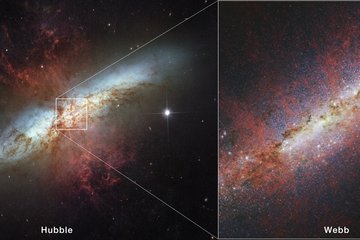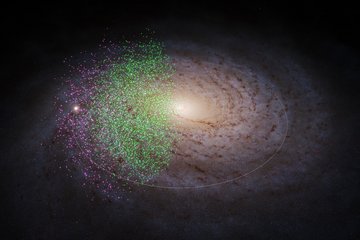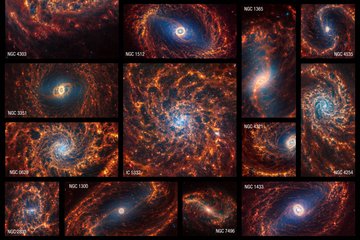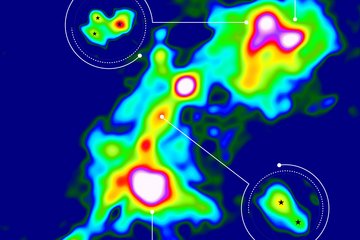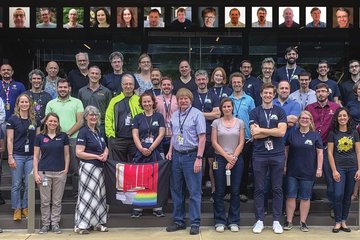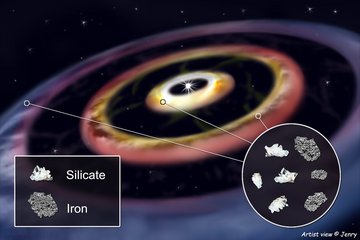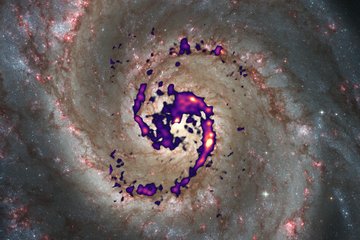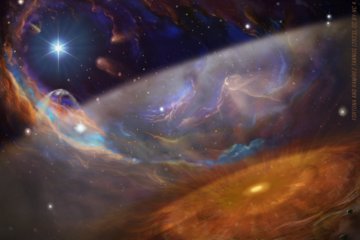JWST peers into the atmosphere of a fluffy exoplanet
Observations with JWST’s MIRI detect water vapour, sulfur dioxide and sand clouds in the atmosphere of WASP-107b.
A team of European astronomers, co-led by MPIA researchers, used recent observations made with the James Webb Space Telescope (JWST) to study the atmosphere of the nearby exoplanet WASP-107b. By peering deep into its fluffy atmosphere, they discovered water vapour, sulfur dioxide, and even silicate sand clouds. These particles reside within a dynamic atmosphere that exhibits vigorous transport of material. The results of the study appeared today in the prestigious journal Nature.

WASP-107b is a unique gaseous exoplanet that orbits a star slightly cooler and less massive than our Sun. The planet’s mass is similar to Neptune’s, but its size is much larger, almost approaching Jupiter’s size. This property renders WASP-107b rather ‘fluffy’ compared to the gas giant planets within the Solar System. It enables astronomers to look roughly 50 times deeper into its atmosphere than the depth of exploration achieved for a solar system giant like Jupiter.
Webb’s mid-infrared instrument reveals the chemistry
The team of European astronomers took full advantage of the remarkable fluffiness of this exoplanet by observing it with the Mid-Infrared Instrument (MIRI) aboard the James Webb Space Telescope (JWST). This opportunity opened a window to look deep into its atmosphere, unravelling its complex chemical composition. The reason behind this is relatively straightforward: the signals, or spectral features, are far more prominent in a less dense atmosphere compared to a more compact one. Their recent study, now published in Nature, reveals the presence of water vapour, sulfur dioxide (SO2), and silicate clouds, but notably, there is no trace of the greenhouse gas methane (CH4).
These detections provide crucial insights into the dynamics and chemistry of this captivating exoplanet. First, the absence of methane hints at a potentially warm interior, offering a tantalizing glimpse into the transport of heat energy in the planet’s atmosphere. Secondly, the discovery of sulfur dioxide (known for the odour of burnt matches) was a major surprise. Previous computations had predicted its absence, but novel climate models of WASP-107b’s atmosphere now show that its fluffy nature accommodates the formation of sulfur dioxide. Even though its rather cool host star emits a relatively small fraction of high-energy photons, they can reach deep into the planet’s atmosphere. This circumstance enables the chemical reactions required to produce sulfur dioxide.
WASP-107b’s weather report predicts sand clouds
But that’s not all they found. The spectral features of sulfur dioxide and water vapour are significantly diminished compared to what they would be in a cloudless scenario. High-altitude clouds partially obscure the water vapour and sulfur dioxide in the atmosphere. While clouds made of different substances have been inferred on other exoplanets via indirect means, this marks the first instance where astronomers can definitively identify their chemical composition. In this case, the clouds consist of small silicate particles, a familiar substance found in many parts of the world as the primary constituent of sand.
“JWST is revolutionizing exoplanet characterization, providing unprecedented insights at remarkable speed,“ says lead author Leen Decin of KU Leuven. “The discovery of clouds of sand, water, and sulfur dioxide on this fluffy exoplanet by JWST’s MIRI instrument is a pivotal milestone. It reshapes our understanding of planetary formation and evolution, shedding new light on our own Solar System.”
Co-author Paul Mollière from the Max Planck Institute of Astronomy (MPIA) in Heidelberg, Germany, agrees: „The value of JWST cannot be overstated: wherever we look with this telescope, we always see something new and unexpected. This latest result is no exception.“
An exotic atmospheric cycle of silicate droplets
In contrast to Earth’s atmosphere, where water freezes at low temperatures, silicate particles can freeze out to form clouds in gaseous planets that attain temperatures around 1000 degrees Celsius. However, in the case of WASP-107b, where the outer atmosphere becomes as hot as approximately 500 degrees Celsius, traditional models predicted that these silicate clouds should form deeper within the atmosphere, where temperatures are substantially higher. In addition, high-altitude sand clouds rain down to lower layers. How is it then possible that these sand clouds exist at high altitudes and continue to endure?
“The fact that we see these sand clouds high up in the atmosphere must mean that the sand rain droplets evaporate in deeper, very hot layers. The resulting silicate vapour is efficiently lifted up,” lead author Michiel Min from SRON (Netherlands Institute for Space Research) explains. “Here, they recondense to form silicate clouds once more. This is similar to Earth’s water vapour and cloud cycle but with sand droplets.” This continuous cycle of sublimation and condensation through vertical transport is responsible for the sustained presence of sand clouds in WASP-107b’s atmosphere.
This pioneering research sheds light on the exotic world of WASP-107b and pushes the boundaries of our understanding of exoplanetary atmospheres. It marks a significant milestone in exoplanetary exploration, revealing the intricate interplay of chemicals and climatic conditions on these distant worlds.
JWST and MIRI are powerful tools to explore exoplanet atmospheres

Astronomers start by measuring the star’s light when the exoplanet is not transiting. This is the baseline starlight. As the exoplanet crosses in front of its host star, it partially blocks the starlight. At the same time, some starlight passes through the exoplanet’s atmospher. MIRI registers the total light (starlight plus starlight that passes through the exoplanet’s atmosphere) during transit. For each wavelength, scientists calculate the amount of starlight blocked by the planet and its atmosphere (white circles) by subtracting the baseline starlight from the total light measured during transit.
The spectrum covers wavelengths between 4.61 and 11.83 microns. The data are complemented with Hubble data, ranging from 1.1 to 1.7 microns. The solid orange line is the best model fit to the JWST and Hubble data. The shaded coloured regions indicate the contribution of water vapour (in red), sulfur dioxide (in blue), and sand clouds (in yellow) to the best-fit model.
“MPIA is proud to have provided key elements to MIRI,” says Thomas Henning, MIRI co-PI and Director at MPIA. “Among them are the filter wheels of MIRI’s photometer and spectrometer, as well as the mechanisms that position the wavelength-selecting elements which produced the spectra containing the chemical signatures.” MPIA staff members have also supported MIRI’s on-ground and in-flight tests.
“With colleagues across Europe and the United States, we have been building and testing the MIRI instrument for almost 20 years. It is rewarding to see our instrument unravel the atmosphere of this intriguing exoplanet,” says instrument specialist and MIRI co-PI Bart Vandenbussche of KU Leuven.
MPIA scientist and co-I of the observing program Jeroen Bouwman adds, “This study combines the results of several independent analyses of the JWST observations and represents the years of work invested not only in building the MIRI instrument but also in the calibration and analysis tools for the observational data acquired with MIRI.”
Background information
These observations were obtained as part of the Guaranteed Time Observation program 1280.
JWST is the world’s premier space science observatory. It is solving mysteries in our solar system, looking beyond to distant worlds around other stars, and probing our universe’s mysterious structures and origins and our place in it. Webb is an international program led by NASA with its partners, ESA (European Space Agency) and CSA (Canadian Space Agency).
JWST’s Mid-InfraRed Instrument (MIRI), built by a European consortium of research institutions, is a multi-purpose scientific instrument for infrared wavelengths between 5 and 28 microns. It combines an imaging camera with a spectrograph. With the support of industrial partners, MPIA provided the mechanisms of all the wavelength range control elements, such as filter and grating wheels, and led the electrical design of MIRI.
The European consortium comprises 46 astronomers from 29 research institutions across 12 countries. The MPIA team comprises Jeroen Bouwman, Paul Mollière, Thomas Henning, Oliver Krause, and Silvia Scheithauer.
This press release has been adapted from the original published by KU Leuven.
MN



